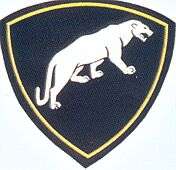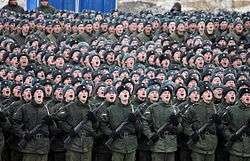Separate Operational Purpose Division
The Separate Operational Purpose Division or ODON, formerly called OMSDON (a.k.a. Dzerzhinsky Division), is a rapid deployment internal security division of the Internal Troops of the Ministry of Internal Affairs of the USSR and then the Russian Federation, today of the National Guard Forces Command of the Russian Federation.[1] ODON (Russian: ОДОН) is an initialism for Отдельная дивизия оперативного назначения (Otdel'naya diviziya operativnogo naznacheniya, English: Separate Operational Purpose Division).
| Separate Operational Purpose Division | |
|---|---|
| Otdel'naya diviziya operativnogo naznacheniya ODON | |
 ODON shoulder patch | |
| Active | June 17, 1924 – present |
| Country | |
| Branch | Internal Troops (until 2016) National Guard Forces Command (since 2016) |
| Type | Motorized infantry |
| Role | Protection of public order |
| Size | ~ 18,000 |
| Part of | |
| Garrison/HQ | Reutov Balashikha |
| Nickname(s) | Dzerzhinsky Division |
| Motto(s) | "At any time, any place - any task!" |
| March | "My Division" |
| Anniversaries | June 17 |
| Engagements | Winter War German-Soviet War Tbilisi tragedy August Coup Russian constitutional crisis of 1993 First Chechen War Second Chechen War Peace enforcement:
|
| Decorations | |
| Commanders | |
| Current commander | Major General Dmitriy Cherepanov |
USSR
The precursor to the ODON was the 1st Automobile Fighting Detachment of the VTsIK (Russian: 1-й автобоевой отряд) which was created in February 1918. The detachment was tasked with guarding the members of the VTsIK and the Sovnarkom and providing them with passenger cars. After relocation of the government to Moscow in March 1918, it was assigned to guarding the Moscow Kremlin as the site of the government alongside the Red Latvian Riflemen, then the "Kremlin cadets" (Russian: "Кремлёвские курсанты"). The detachment was renamed 1st Armored Car Detachment 'Ya. M. Sverdlov' in 1919, and was transferred to VChK in 1921. At the peak of its strength, the detachment had over 400 troops.
In April 1921, VChK created the OSNAZ battalion which consisted of 1st Armored Car Detachment, three rifle platoons, a cavalry squadron, and various auxiliary units, with a total strength of some 1,100 men. VChK became OGPU in 1922, and the OSNAZ was renamed accordingly.
On 17 June 1924, the OSNAZ battalion, an OGPU rifle battalion and an OGPU rifle regiments formed the Special-Purpose Division (DON) of the OGPU Troops. The DON included 4 rifle regiments with an Armored Car detachment. In August 1926, the division was renamed Special-Purpose Division 'F. E. Dzerzhinsky' of the OGPU Troops. Throughout 1926, one more regiment and five more battalions joined the DON, raising its total strength to some 4,500 troops.
In 1929, the DON was reorganized as a full army division. In 1931, the Armoured Car detachment was reorganized into an armoured regiment. In 1934, OGPU was transferred to the People's Commissariat for Internal Affairs (the NKVD). The division fought on the front lines of the Winter War against Finland.
With the onset of World War II, parts of the division participated in the Battle of Moscow, the remaining unit guarded particularly important installations of the capital, patrolled the streets, and were involved in efforts to liquidate enemy infiltrator groups near the front and in the city.
Along with participation in hostilities, division elements in Moscow detained 485 enemy intelligence agents, 69,753 deserters, over 320,000 offenders of the established regime.
The division took part in the 1941 October Revolution Parade on Moscow's Red Square.
In the battle against German troops, the snipers of the 4 Cavalry Regiment (later four motorized infantry) distinguished themselves. On the first deployment of the two sniper Regiments in 1942, they killed 853 German soldiers and officers. In total, in 1942 sniper division has killed 6,440 German soldiers and officers.
The OMSDON units protected the Allied leaders during the Yalta conference.
In preparation for the 1980 Moscow Olympics, an elite group of OMSDON troops was trained with special forces tactics; the core of this group later became the Vytyaz unit. The final USSR designation of the division was OMSDON (Independent Special-Purpose Motorized Rifle Division of the Internal Troops of the MVD of the Soviet Union 'F. E. Dzerzhinsky', Russian: ОМСДОН, Отдельная мотострелковая дивизия особого назначения ВВ МВД им. Ф. Е. Дзержинского).
Russian Federation
In 1994, the OMSDON was renamed as the Independent Operational Purpose Division or ODON. The unit has been once again named after F. E. Dzerzhinsky on October 22, 2014,[2] returning therefore to the full title of the Independent Medals of Zhukov, Lenin and October Revolution Red Banner Operational Purpose Division of the Internal Troops of the Ministry of Internal Affairs of Russia 'F. E. Dzerzhinsky' (Russian: Отдельная орденов Жукова, Ленина и Октябрьской Революции Краснознамённая дивизия оперативного назначения Внутренних войск МВД России им. Ф. Е. Дзержинского). As always they form the first line of security during important events held in Russia, and represent the Internal Troops during the yearly Moscow Victory Parade and the Moscow November 7 Anniversary Parade (the latter because they attended that very October 1941 Revolution Day parade which was the only parade held in the midst of the Great Patriotic War).
With the formation of the National Guard of Russia, the ODON was officially, in April 2016, retitled as the Independent Orders of Zhukov, Lenin and October Revolution Red Banner Operational Purpose Division of the National Guard Forces Command of the Russian Federation 'F. E. Dzerzhinsky' (Russian: Отдельная орденов Жукова, Ленина и Октябрьской Революции Краснознамённая дивизия оперативного назначения Войск национальной гвардии Российской Федерации им. Ф. Е. Дзержинского).
Composition

The division includes the following military units (as of 1 January 2013):
- 604th Special Purpose Center, w / h 3179, formed in 2008 combining (Vityaz and Rus)
- 2nd Operational Duties Regiment, w / h 3186
- 4th Operational Duties Regiment, w / h 3419
- 5th Operational Duties Regiment, w / h 3500
- 16th Training Center, w / h 3421
- 319th Battalion for the protection and security training centers (centers village. New and Noginsk, Moscow region), in / hr 3058
- 344th Command Battalion, a / h 6771 (ORRiKS in / hr 3486)
- Communications Battalion, a / h 3128
- Repair and Refurbishment Battalion, w / h 3187
- Selected Medical Battalion, w / h 3532
- 4th separate company for radiation, chemical and biological protection, w / h 3401
- Garrison quarters and operations area, a / h 3492
- 441st Security Battalion, in / hr 6909 (formed in November–December 2012)
- 752nd Engineering Battalion, w / h 6923
Therefore, the entire division employs more than ten thousand personnel, hundreds of armoured vehicles, and divisional artillery (mortars and anti-aircraft guns).